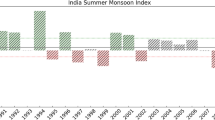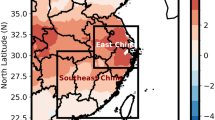Abstract
Melting layer usually exists in precipitation where ice particles gradually melt into liquid particles. Utilizing the detection from the Dual-frequency Precipitation Radar onboard Global Precipitation Measurement Mission Core Observatory during 2018-2022, this paper investigates the quasi-global climatological features of Melting layer over 65°S ~65°N and analyzes the relationships with elevation in the golden case involving the section along 32.5°N across China. The distribution of Melting layer is latitude-dependent: Melting layer is higher in 30°S~30°N and decrease toward the mid-and high-latitude, which are generally lower in 30°S~65°S throughout the year. The height and thickness of Melting layer change more dramatically in mid-and high latitudes than in low latitudes for diurnal variations. The higher elevation terrain has the lower Melting layer top height than other terrains, yet the geometric thickness of Melting layer is also thinner. A golden case is selected to represent the analysis of Melting layer play role in rainfall. When the Melting layer grow thinner with steeply rising elevation due to the thermal change and orographic uplift, there is weak rain with a greater number of smaller raindrops in the golden case. However, Melting layer can get widen and raindrops can get sufficient growth as the elevation declines.









Similar content being viewed by others
Data availability
No datasets were generated or analysed during the current study.
References
Awaka J, Le M, Chandrasekar V, Yoshida N, Higashiuwatoko T, Kubota T, Iguchi T (2016) Rain Type Classification Algorithm Module for GPM Dual-Frequency Precipitation Radar. J Atmos Ocean Technol 33(9):1887–1898. https://doi.org/10.1175/JTECH-D-16-0016.1
Baldini L, Gorgucci E (2006) Identification of the Melting Layer through Dual-Polarization Radar Measurements at Vertical Incidence. J Atmos Ocean Technol 23(6):829–839
Battaglia A, Mroz K, Cecil D (2022) Satellite hail detection. Precipitation Science, pp 257–286
Brast M, Markmann P (2020) Detecting the melting layer with a micro rain radar using a neural network approach. Atmos Meas Tech 13(12):6645–6656
Chandrasekar V, Zafar B (2004) Precipitation type determination from spaceborne radar observations. IEEE Trans Geosci Remote Sens 42(10):2248–2253
Chen Y, Fu Y, Xian T, Pan X (2017) Characteristics of cloud cluster over the steep southern slopes of the Himalayas observed by CloudSat. Int J Climatol 37(11):4043–4052
Fabry F, Bell C, Szyrmer W, Zawadzki I (2005) Modeling of the Melting Layer. Part III: The Density Effect. J Atmos Sci 62(10):3705–3723
Fabry F, Zawadzki I (1995) Long-term radar observations of the melting layer of precipitation and their interpretation. J Atmos Sci 52
Feng S, Fu Y, Xiao Q (2011) Is the tropopause higher over the tibetan plateau? Observational evidence from Constellation Observing System for Meteorology, Ionosphere, and Climate (COSMIC) data. J Geophys Res Atmos 116(D21)
Feng S, Fu Y, Xiao Q (2012) Trends in the global tropopause thickness revealed by radiosondes. Geophys Res Lett 39(20)
Fu Y, Ma Y, Zhong L, Yang Y, Guo X, Wang C et al (2020) Land-surface processes and summer-cloud-precipitation characteristics in the Tibetan Plateau and their effects on downstream weather: a review and perspective. Natl Sci Rev 7(3):500–515 (https://www.ncbi.nlm.nih.gov/pubmed/34692070). Accessed 12 Mar 2024
Fu Y, Pan X, Xian T, Liu G, Zhong L, Liu Q et al (2017) Precipitation characteristics over the steep slope of the Himalayas in rainy season observed by TRMM PR and VIRS. Clim Dyn 51(5–6):1971–1989
Heymsfield AJ, Bansemer A, Theis A, Schmitt C (2021) Survival of snow in the melting layer: relative humidity influence. J Atmos Sci 78
Hou AY, Kakar RK, Neeck S, Azarbarzin AA, Kummerow CD, Kojima M et al (2014) The global precipitation measurement mission. Bull Am Meteorol Soc 95(5):701–722. https://doi.org/10.1175/BAMS-D-13-00164.1
Houze RA (2012) Orographic effects on precipitating clouds. Rev Geophys 50(1)
Houze RA, Yuan J (2010) Global Variability of Mesoscale Convective System Anvil Structure from A-Train Satellite Data. J Clim 23(21):5864–5888
Hu X, Ai W, Qiao J, Hu S, Han D, Yan W (2022) Microphysics of summer precipitation over yangtze-huai river valley region in china revealed by GPM DPR observation. Earth Space Sci 9(3)
Humphries RS, Keywood MD, Gribben S, McRobert IM, Ward JP, Selleck P et al (2021) Southern Ocean latitudinal gradients of cloud condensation nuclei. Atmos Chem Phys 21(16):12757–12782
Iguchi T (2020) Dual-frequency precipitation radar (DPR) on the global precipitation measurement (GPM) mission’s core observatory. Satellite Precipitation Measurement, pp 183–192
Klaassen W (1988) Radar observations and simulation of the melting layer of precipitation. J Atmos Sci 45(24):3741–3753
Kollias P, Albrecht B (2005) Why the melting layer radar reflectivity is not bright at 94 GHz. Geophys Res Lett 32(24)
Langston C, Zhang J, Howard K (2008) Brightband Identification Based on Vertical Profiles of Reflectivity from the WSR-88D. J Atmos Ocean Technol 25(10):1859–1872
Le M, Chandrasekar V (2013a) Hydrometeor Profile Characterization Method for Dual-Frequency Precipitation Radar Onboard the GPM. IEEE Trans Geosci Remote Sens 51(6):3648–3658 (http://ieeexplore.ieee.org/ielx5/36/6516926/06392933.pdf?tp=&arnumber=6392933&isnumber=6516926). Accessed 12 Mar 2024
Le M, Chandrasekar V (2013b) Precipitation Type Classification Method for Dual-Frequency Precipitation Radar (DPR) Onboard the GPM. IEEE Trans Geosci Remote Sens 51(3):1784–1790 (http://ieeexplore.ieee.org/ielx5/36/6469260/06259852.pdf?tp=&arnumber=6259852&isnumber=6469260). Accessed 12 Mar 2024
Le, M., & Chandrasekar, V. (2014, 16-23 Aug. 2014). Dual-frequency precipitation radar estimation of rainfall rate: Potential application to global precipitation mission. Paper presented at the General Assembly and Scientific Symposium (URSI GASS), 2014 XXXIth URSI
Li H, Moisseev D (2019) Melting Layer Attenuation at Ka- and W-Bands as Derived From Multifrequency Radar Doppler Spectra Observations. J Geophys Res Atmos 124(16):9520–9533
Li H, Moisseev D (2020) Two Layers of Melting Ice Particles Within a Single Radar Bright Band: Interpretation and Implications. Geophys Res Lett 47(13)
Li H, Tiira J, von Lerber A, Moisseev D (2020) Towards the connection between snow microphysics and melting layer: insights from multifrequency and dual-polarization radar observations during BAECC. Atmos Chem Phys 20(15):9547–9562
Liao L, Meneghini R (2010) A Study on the Feasibility of Dual-Wavelength Radar for Identification of Hydrometeor Phases. J Appl Meteorol Climatol 50(2):449–456. https://doi.org/10.1175/2010JAMC2499.1
Matrosov SY (2008) Assessment of Radar Signal Attenuation Caused by the Melting Hydrometeor Layer. IEEE Trans Geosci Remote Sens 46(4):1039–1047
McMurdie LA, Rowe AK, Houze RA Jr, Brodzik SR, Zagrodnik JP, Schuldt TM (2018) Terrain-Enhanced Precipitation Processes Above the Melting Layer: Results From OLYMPEX. J Geophys Res Atmos 123(21):12194–12209 (https://www.ncbi.nlm.nih.gov/pubmed/30775193). Accessed 12 Mar 2024
Qiao J, Ai W, Hu X, Hu S, Du X (2022a) Characteristics of melting layer in cyclones over the western north pacific detected by the gpm dual-frequency precipitation radar. Earth Space Sci 9(3)
Qiao J, Ai W, Hu X, Liu M, Hu S (2022b) An identification method of melting layer using the covariance wavelet transform based on gpm-dpr observations. Earth Space Sci 9(3)
Rind D (1998) Latitudinal temperature gradients and climate change. J Geophys Res Atmos 103(D6):5943–5971
Ryu J, Song HJ, Sohn BJ, Liu C (2021) Global distribution of three types of drop size distribution representing heavy rainfall from gpm/dpr measurements. Geophys Res Lett 48(3)
Sassen K, Campbell JR, Zhu J, Kollias P, Shupe M, Williams C (2005) Lidar and triple-wavelength doppler radar measurements of the melting layer: a revised model for dark- and brightband phenomena. J Appl Meteorol Climatol 44(3):301–312
Sassen K, Matrosov S, Campbell J (2007) CloudSat spaceborne 94 GHz radar bright bands in the melting layer: An attenuation-driven upside-down lidar analog. Geophys Res Lett 34(16)
Shin D-B, North GR, Bowman KP (2000) A Summary of Reflectivity Profiles from the First Year of TRMM Radar Data. J Clim 13(23):4072–4086
Song JI, Yum SS, Park SH, Kim KH, Park KJ, Joo SW (2021) Climatology of melting layer heights estimated from cloud radar observations at various locations. J Geophys Res Atmos 126(17)
Stewart RE, Marwitz JD, Pace JC, Carbone RE (1984) Characteristics through the melting layer of stratiform clouds. J Atmos Sci 41(22):3227–3237
Sun Y, Dong X, Cui W, Zhou Z, Fu Z, Zhou L et al (2020) vertical structures of typical meiyu precipitation events retrieved from GPM-DPR. J Geophys Res Atmos 125(1)
Vivekanandan J, Zrnic DS, Ellis SM, Oye R, Ryzhkov AV, Straka J (1999) Cloud microphysics retrieval using s-band dual-polarization radar measurements. Bull Am Meteorol Soc 80(3):381–388
Wang M, Fu Y, Zhao C, Zhong L, Li R, Wang D et al (2022) Characteristics of summer cloud precipitation along latitude 30°N in East Asia derived from Tropical Rainfall Measuring Mission Precipitation Radar and Visible and Infrared Scanner measurements. Int J Climatol 42
Zagrodnik JP, McMurdie L, Conrick R (2021) Microphysical enhancement processes within stratiform precipitation on the barrier and sub-barrier scale of the olympic mountains. Mon Weather Rev 149(2):503–520
Zhang Y, Wang K (2021) Global precipitation system size. Environ Res Lett 16(5)
Zhou L, Xu G, Xiao Y, Wan R, Wang J, Leng L (2022) Vertical structures of abrupt heavy rainfall events over southwest China with complex topography detected by dual-frequency precipitation radar of global precipitation measurement satellite. Int J Climatol 1
Zhou Z, Zhang Q, Allen JT, Ni X, Ng CP (2021) How many types of severe hailstorm environments are there globally? Geophys Res Lett 48(23)
Acknowledgements
We are grateful to the National Aeronautics and Space Administration (NASA) and Japan Aerospace Exploration Agency (JAXA) for providing the GPM DPR data.
The V07A GPM 2ADPR products used in this paper are openly available at the NASA Goddard Space Flight Center's Precipitation Processing System (PPS) team (https://storm.pps.eosdis.nasa.gov/storm/, which could be accessed until March 12, 2024).
This paper is supported by no Funding and has no Competing interests.
Author information
Authors and Affiliations
Contributions
Conceptualization: Xiong Hu, Junqi Qiao, Data curation: Weihua Ai, Junqi Qiao, Formal analysis: Xiong Hu, Junqi Qiao, Investigation: Xiong Hu, Junqi Qiao, Methodology: Xiong Hu, Junqi Qiao, Project Administration: Weihua Ai, Supervision: Weihua Ai, Wei Yan, Validation: Xiong Hu, Visualization: Xiong Hu, Writing – original draft: Xiong Hu, Writing – review & editing: Xiong Hu, Weihua Ai
Corresponding author
Ethics declarations
Competing interests
The authors declare no competing interests.
Additional information
Publisher’s Note
Springer Nature remains neutral with regard to jurisdictional claims in published maps and institutional affiliations.
Keypoints
• ML height is higher in low-latitude and decreases toward the mid-and high-latitude, which are generally lower in southern high-latitude.
• The diurnal variations of ML height and geometric thickness vary more significantly in mid-and high-latitude than that in low-latitude.
• ML height is lower in higher elevations than in other terrains, yet the geometric thickness of the melting layer is also thinner.
Rights and permissions
Springer Nature or its licensor (e.g. a society or other partner) holds exclusive rights to this article under a publishing agreement with the author(s) or other rightsholder(s); author self-archiving of the accepted manuscript version of this article is solely governed by the terms of such publishing agreement and applicable law.
About this article
Cite this article
Hu, X., Ai, W., Qiao, J. et al. Insight into global climatology of melting layer: latitudinal dependence and orographic relief. Theor Appl Climatol (2024). https://doi.org/10.1007/s00704-024-04926-6
Received:
Accepted:
Published:
DOI: https://doi.org/10.1007/s00704-024-04926-6




